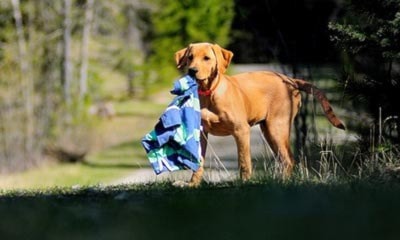By Cam Fortems
Kamloops This Week
The handler places a rag atop a fallen Douglas fir, the ramp sloping upwards to a point nearly two metres above the forest floor.
With gentle hands, comforting noises and encouragement — and arms at the ready to catch a fall — Mike Ritcey leads his 13-week old puppy, Ruby, up the log where she stoops and grabs it in her mouth.
A few minutes earlier, Ritcey’s longtime companion and working dog Juno found the piece of a shirt, walked up the log, carefully spun and came down the same way like a pro.
“You train them when they’re a pup and there’s no hesitation,” Ritcey said, scooping the puppy up in his arms and placing her on the ground.
“You want that first experience to be good. You don’t want her crashing to the ground.”
Ritcey is a retired paramedic, lifelong outdoorsman and 40-year veteran of search and rescue
It’s early days for Ruby, the gangly yellow Labrador retriever who will one day replace six-year-old Juno when the day comes for retirement — when her legs can no longer drive her across creeks, over logs and up hillsides searching by scent for something in the forest that shouldn’t be there, something that’s different.
All the experiences for the curious Ruby, whose drive to meet new people at this age sometimes overpowers the games Ritcey has designed for her, are designed to make her one of the few validated search and rescue dogs in the province. Ruby is one of about 20 in B.C., along with a newly validated weimaraner also based in Kamloops.
RCMP dog handlers assist search and rescue trainers. Ruby and the golden retrievers, German shepherds and other Labs that make up the bulk of the canine workforce (Ritcey calls them “high-drive dogs”) cannot be called out until police make the call.
Unlike police dogs, search and rescue dogs are not trained to follow a track. Instead, they search for items, or a disturbance that smells different.
“It’s something different that shouldn’t be there,” he explained. “They don’t need a scent for something (item of clothing from the missing person). They can distinguish your scent from my scent.”
The games and training never stop for Ruby, who will be recertified every year if she passes her initial validation.
Farther up the road, Ritcey earlier stashed a soaking hat under a creek bank. Juno circled the area in a small radius, crossing the creek and then trudging up the running water until she reached down and triumphantly yanked out the hat, jogging back to Ritcey who lavished praise.
“Whoaa — good dog,” he exclaimed, adding a bit sheepishly. “They say if you’re not making an idiot of yourself, you’re not doing a good job.”
The rewards are the time-honoured bits of dog treat. But Ritcey said this time he will forgo the food and instead use what’s called “ragging” — a quick game of tug as a reward in order to keep Ruby’s drive to work higher.
The work on a search and rescue mission can be arduous, particularly in rugged terrain, with the handler trailing a dog equipped with a GPS collar to clear an area.
Canines’ remarkable sense of smell allows them to do remarkable things. Ritcey said at a recent event held for search and rescue dogs, trainers placed an items in a lake..
“The dogs would swim around and dive down four feet to get them.”
The events are also good training because dogs will compete with each other, elevating their skills in the process.
Ruby will face her first big test with a validation aimed at six-month old puppies to ensure they’re on the right track. A full validation comes later.
